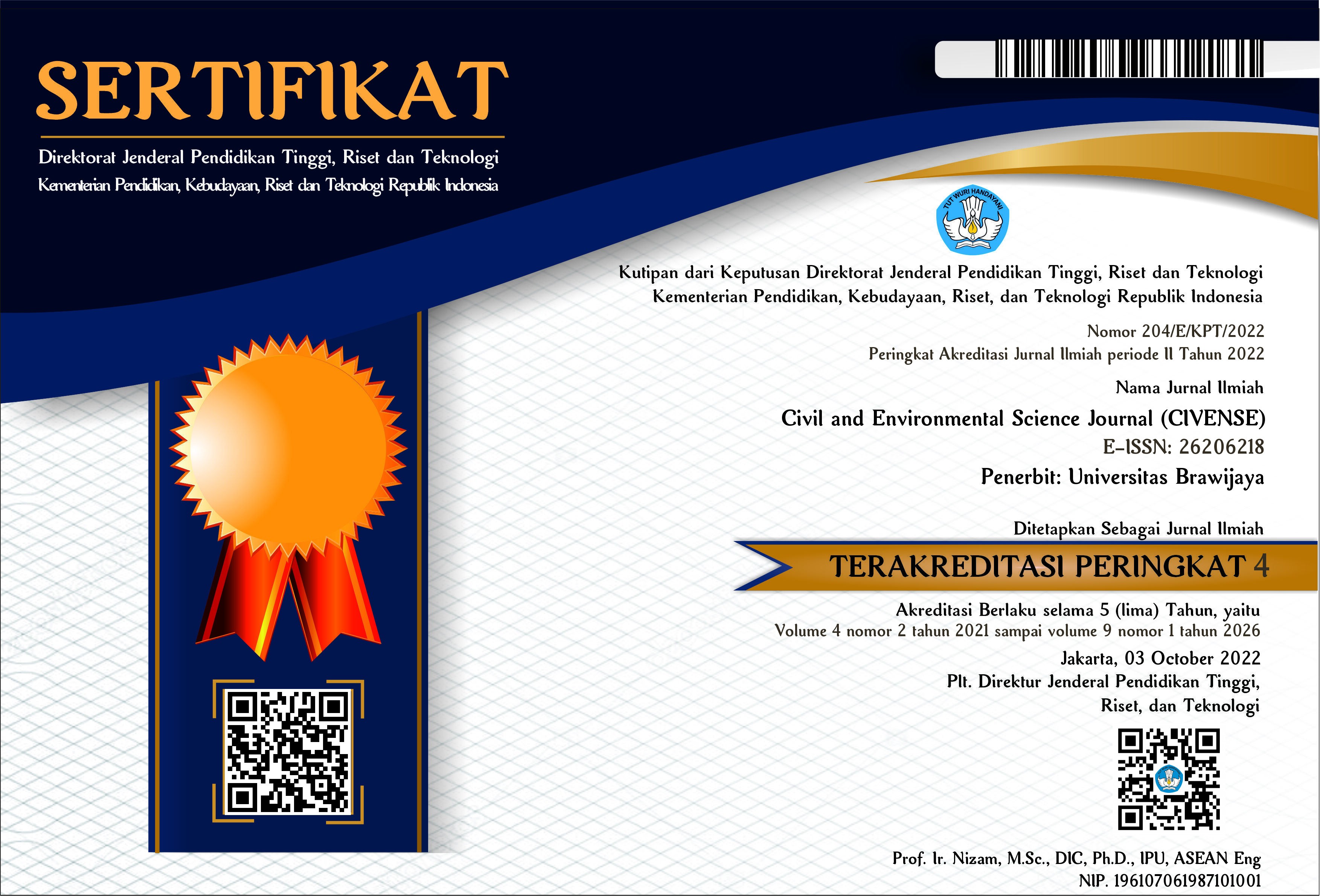El-nino effect on reservoir volumetric (A case study of the Batujai Dam on the island of Lombok)
DOI:
https://doi.org/10.21776/ub.civense.2019.00202.1Keywords:
El-Nino, impact, reservoir, volumetricAbstract
El-Nino has been occurred from 1952 to 2016 with the types of weak, medium, strong and very strong. The event of El-Nino has significant impact on all aspects of economy, social, industry and agriculture. There is a decrease in the quantity of water resources such as in the reservoir where the reservoir inflow becomes very small and the water outflow becomes high. At the event of very strong El-Nino is occurred some of the reservoirs will dry. The aim of the research is to investigate the deficit capacity of the reservoir in the event of El-Nino. The data analyzed in this article were the volume of the half-month reservoir, especially in the event of El-Nino events. The analysis of frequency deficit probability was using Weibull probability and Log Pearson Type III distribution. The results show significant decrease in reservoir water volume over a very long-time period. The reservoir volume never reached maximum water level and persists for almost one year. The deficit of reservoir volumes reached was 16,01x106 m3, 18.64x106 m3, and 21,07x103 m3 for weak, moderate, and very strong El-Nino, respectively.References
Ahidul I, Thian Y.G. 2015 Potential combined hydrologic impacts of climate change and El Niño Southern Oscillation to South Saskatchewan River Basin, Journal of Hydrology
Bhubaneswar K., Geethalakshmi V. 2013 The Impact of El Niño/Southern Oscillation on Hydrology and Rice Productivity in the Cauvery Basin, India: Application of the Soil and Water Assessment Tool, Weather and Climate Extremes
Chuthamat C., Adebayo J. Adeloye, and Soundharajan B.S. 2016 Inflow forecasting using Artificial Neural Networks for reservoir operation, IAHS, 373, 209–214
Jie-Lun C, Yu-Shiue T. 2012 Reservoir Drought Prediction Using Support Vector Machines, Applied Mechanics and Materials Vol. 145 (2012) pp 455-459
Keener V.W., Feyereisen G.W., Lall U., Jones J.W., Bosch D.D., R. Lowrance R. 2010 El-Niño/Southern Oscillation (ENSO) influences on monthly NO3 concentration, stream flow and precipitation in the Little River Watershed, Tifton, Georgia (GA) Journal of Hydrology, 381 (2010) 352–363
Neil M.W., Casey M. B., Kye M. B., Yasir H. K. 2013 Reservoir performance and dynamic management under plausible assumptions of future climate over seasons to decades, Climatic Change (2013) 118:307–320
Shu-Yi L., Chi-Chung C., Shih-Hsun H. 2010 Estimating the value of El Niño Southern Oscillation information in a regional water market with implications for water management, Journal of Hydrology
Shiau J.T. 2003 Water Release Policy Effects on the Shortage Characteristics for the Shihmen Reservoir System during Droughts, Water Resources Management 17: 463–480, 2003
Uriel F. H. A., Mélanie T., Robert L. 2014 Impacts and Adaptation to Climate Change Using a Reservoir Management Tool to a Northern Watershed: Application to Lièvre River Watershed, Quebec, Canada, Water Resour Manage, 28:3667–3680
Downloads
Published
How to Cite
Issue
Section
License
Copyright (c) 2019 Civil and Environmental Science Journal

This work is licensed under a Creative Commons Attribution-NonCommercial 4.0 International License.
Authors who publish with this journal agree to the following terms:
Authors retain copyright and grant the journal right of first publication with the work simultaneously licensed under a Attribution-NonCommercial 4.0 International License that allows others to share the work with an acknowledgement of the work's authorship and initial publication in this journal.
Authors are able to enter into separate, additional contractual arrangements for the non-exclusive distribution of the journal's published version of the work (e.g., post it to an institutional repository or publish it in a book), with an acknowledgement of its initial publication in this journal.
Authors are permitted and encouraged to post their work online (e.g., in institutional repositories or on their website) prior to and during the submission process, as it can lead to productive exchanges, as well as earlier and greater citation of published work (See the Effect of Open Access).














